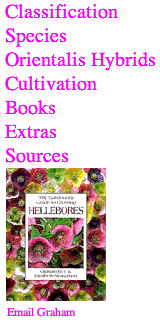

Tie the foliage of the plant together loosely with string then, using a large digging fork, lift the plant. The root system is extensive, so try to remove as much root as possible. Shake off as much soil as you can then barrow the plant to an out-of-the way corner or near a drain. Next, using a hosepipe, wash as much soil off the plant as possible. Put you finger over the end of the pipe, or use an adjustable jet, to generate plenty of pressure to remove stones and soil. If this is impracticable, wash off the soil in an old galvanised bath, an old water tank or a large bucket.
When the soil is washed off the roots, there are again two choices. The plant can be split into a small number of large pieces; the full root system will now be revealed in detail and it is possible to use secateurs, an old bread knife or even a small spade to make divisions, discarding the oldest woodiest of the crown and retain the younger growth.
After tidying up these large pieces they can then be replanted. Alternatively, and this is the most productive approach, these pieces can be further split into smaller sections. Using secateurs cut some of the older woody material away. Try to break the clump down into pieces with one or two leaves, a healthy pointed ‘nose’ (from which new top growth will come) and plenty of pale roots; the black roots are the older roots and will not re-grow to help the plant establish itself.
As each piece is separated trim off any damaged foliage and any long black roots then temporarily place each piece in moist compost or any damp organic matter to prevent drying out. You will sometimes find seedlings growing in the centre of the clump; remember that they will not be identical to the clump which is being divided so either discard them or label them separately.
Your chosen pieces can then either be planted out in a new site, planted in a nursery area for a year or two to develop or potted up for planting once they have started to grow strongly. When planting out in their final flowering site, prepare the soil well; if planting in a nursery area for a year choose a partially shaded site with good soil and fork in weed-free organic matter into the top 12in/30cm of soil and tread well before planting out 9-12in/23-30cm apart. Water them in with a liquid feed, mulch with weed-free organic matter, keep them moist and give them two or three further liquid feeds in the spring.
If you prefer to pot up divisions - the best option for smaller divisions in particular and necessary if the splits are to be given away or taken to a plant sale - use a well-drained, good quality soil-based compost such as John Innes Number 3. The tall, deep pots known as rose pots, or ‘long toms’ are ideal for larger divisions but can be hard to find; large divisions can go in 2l/61/2/in/16cm pots, the smallest can go in 31/2in/9cm pots.
Keep the pots in a sheltered place outside, be sure to sit them on a gravel bed to ensure that the compost drains well and does not become waterlogged. Alternatively, use a cold frame with the lights raised whenever the weather is anything but cold and snowy, or a cold greenhouse; but be sure to ventilate a cold greenhouse thoroughly to keep the temperatures low on sunny days. Look out for aphids at this stage and deal with them accordingly.
Some divisions may flower in the spring after dividing. The flower buds develop during the summer so by the time the plants are divided the embryonic flower buds are already in place. However, to encourage the plants to settle more quickly and to flower productively in succeeding years it pays to remove the flowers as they start to develop.